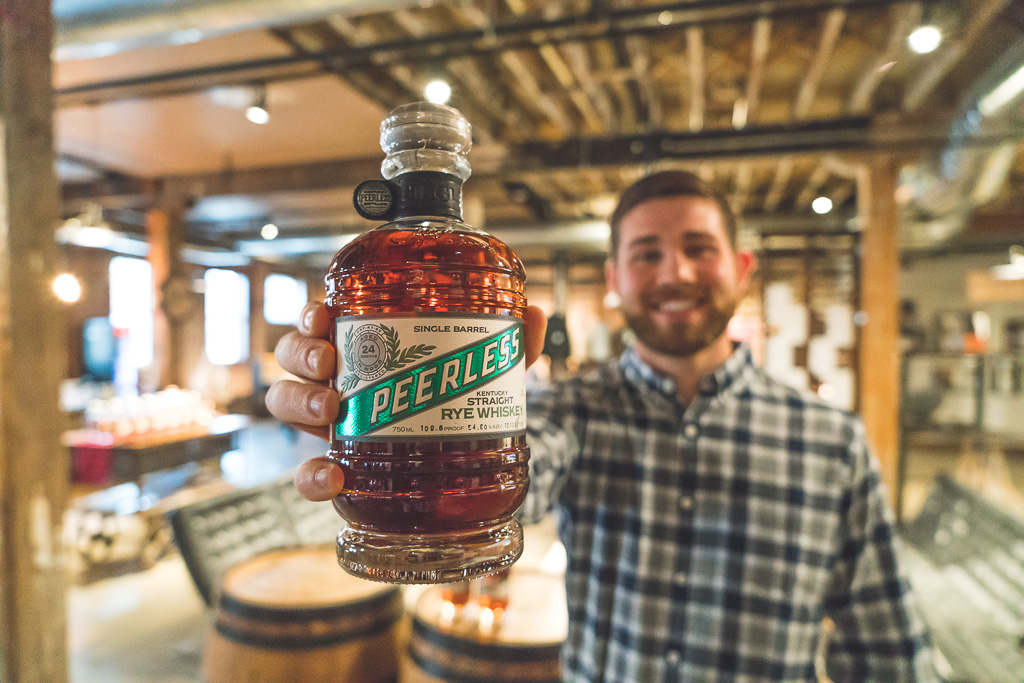
Master Distiller Caleb Kilburn is barely north of 30 and he’s already one of the most respected distillers in Kentucky. Kilburn started on the ground floor of Kentucky Peerless Distilling back in 2014… literally. He got a job, fresh out of college, shoveling gravel from the warehouse shell that would become the new home of Kentucky Peerless Distilling on the far west end of Louisville’s famed Whiskey Row. By March of 2015, Kilburn distilled Peerless’s first batch of rye whiskey. Two years later, the awards started rolling in and haven’t stopped.
Over the past seven years, Peerless has also released award-winning bourbons from its efficient, almost cozy home base, and Kilburn‘s leadership and creativity continue to wow the industry. So I was extra keen to sit down with one of whiskey’s youngest guns to talk about making both a rye whiskey and bourbon whiskey, the differences in everything from fermentation to aging, and what defines both rye and bourbon in his thinking.
It was a free-wheeling conversation that highlights how a Master Distiller thinks and operates. We also dispel some rye myths, break down a sweet mash vs. a sour mash, and talk about what a “sour” flavor note really is. Enjoy!
Also Read: The Top 5 UPROXX Bourbon Posts Of 2021
- The Single Best Bottle Of Whiskey From Each Of The 50 States
- The 50 Best Bourbon Whiskeys Of 2021, Ranked
- Every Winning Bourbon From Our 2021 Taste Tests, Blind Tasted And Re-Ranked
- The Best Value-Per-Dollar Bourbon Whiskeys, Ranked
- All 19 Brands From The Buffalo Trace Distillery, Ranked
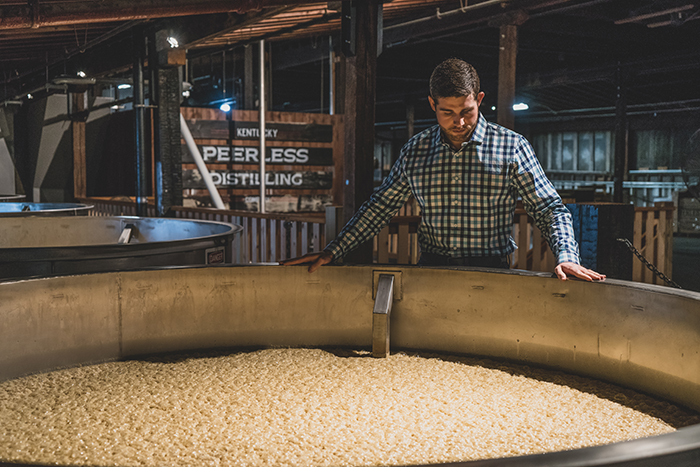
What is the fundamental thing that you love about making rye whiskey?
Well, the thing I love about making rye is the end result. It is not necessarily the product, but the impression it makes on the public. When we get someone who previously maybe didn’t like rye whiskey or maybe had always heard about “harsh” or “pepper” or “spice” and they had assumed that it wasn’t for them, and then you see a twinkle in their eye when we pour them that first sample of Kentucky Peerless Rye and you can just see a light bulb go off and it completely shifts their own definition for whether or not they like rye.
It just expands their horizon and, for me, that’s the most rewarding part of making rye whiskey.
Right on. I like the expanding of horizons. So talk to me about your love of bourbon.
Well, when it comes to bourbon, I mean it is the state’s signature spirit. In fact, it’s the U.S.’s signature spirit. To be able to craft our own space among the greats and come out with what we feel is a really high-quality whiskey, it’s equally as rewarding. It doesn’t quite have as much shock and awe as when you change someone who wasn’t a rye person to a rye person. Most people who love bourbon know what they’re getting, so it is really more or less about recreating Peerlelss’ heritage in spirit form by way of bourbon.
You’re in a very unique position in that you work in a very compact facility.
Yes.
You simply don’t have a lot of room to do whatever you want and just see what happens. How do you balance out the process of making both bourbon and rye, especially when rye is what you became known for?
So really when we’re deciding how much bourbon versus how much rye to make, generally what you’re doing is forecasting what you anticipate the demand will be X number of years in the future. For us, we thought that we were going to make a good impact on rye and we thought the bourbon was going to be very popular. So we worked accordingly. We were very fortunate that prediction has turned out to be the case.
Let’s talk about some practicals of shifting from making rye to making bourbon. What’s the process in that you’re working with a few fermenting tanks that always need to be working?
The good thing, first and foremost, about us doing the sweet mashing process is there is very little carryover. When you talk about a sour mash whiskey, in contrast, you’re always using a starter from the prior batch. So, inherently, when you switch from rye to bourbon, you end up either switching to a sweet mash to start the new batch in the sour mash facility, which introduces a lot of variables, or you use the prior mash bill as the starter for the next one and you get into some real gray areas as far as the product line.
But starting with fresh ingredients every single time, as we do with a sweet mash, eliminates any crossover between the two. So there’s intrinsically a cleaner break doing a sweet mash than there would be if we were doing a sour mash. That makes us a little more nimble as far as being able to switch between products and remain consistent because the first cook of a sweet mash should be, in theory, nearly identical to the hundredth.
Whereas if you’re doing sour mash, you have to start with a piece of a prior fermentation. So if it is day one after doing bourbon, either you’re choosing to break from the sour mash and do sweet mash or you’re choosing to use the bourbon spillage to start your rye. You end up with a lot of gray areas as far as one batch to the next, to the next, to the next…
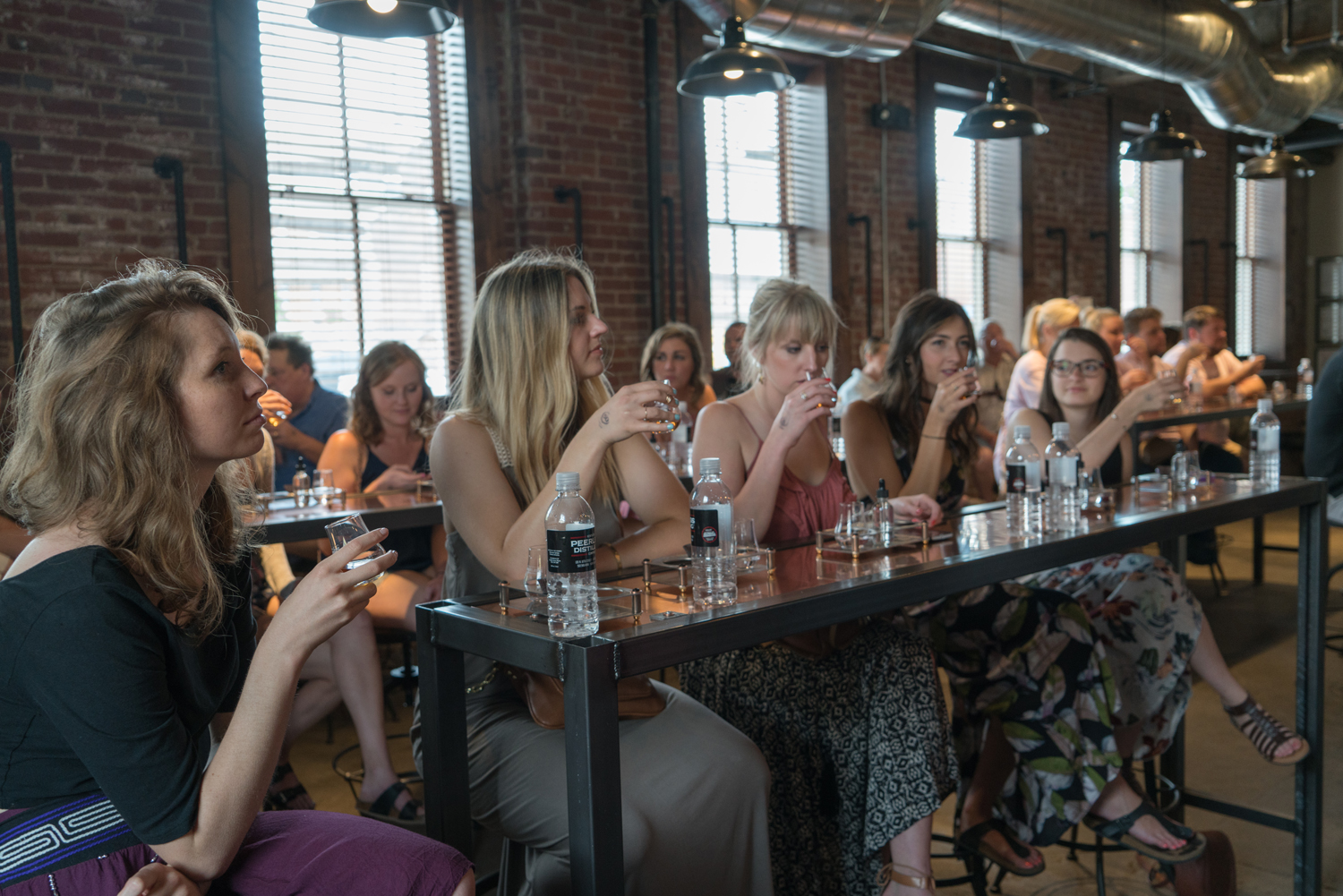
I still remember the first two-year-old rye you dropped, made with a sweet mash, which kind of came out of nowhere and was phenomenal — like blew the lid off of things twice, three times, four times as old. How do you attribute that? Was it the focus on the ingredients? Was it the focus on the atmosphere? What do you feel like was the special sauce there?
For me, I like to think of products as a chain. No one link, no one step in the process makes it strong, but any weak link can knock it all off balance. It can make it useless. So for us, we didn’t start necessarily with this horizon in mind that we want to have the “best two-year-old rye whiskey in the world.” It was, we want to make a really, really, really solid rye that is transcendent of time. It wouldn’t predicate itself based on “oh, it’s going to serve well as a young spirit” or “it’s going to serve well as an old spirit.” But rather, we just wanted to do what we felt were the right steps all along the process and to trust the process. And then what wound up happening was we created a really good rye whiskey and it held up. It obviously made its mark as a two-year-old but it won us a lot of awards as a three-year-old. And now that we are beyond the age statements into the four-plus age year range, it is not slowing down and the product’s only getting better.
As far as attributing the misconception that young spirit is often bad or why ours was actually quite palatable and quite nice, it was the collection of these different practices that we employed here at Peerless. I already introduced using sweet mash, which is where we’re going to start with fresh corn, fresh rye, fresh barley, and first-generation yeast. We’re avoiding that traditional sour mash note, producing a very sweet, very floral beer that when we distill. Which then becomes a very sweet, very floral distillate.
It’s just a different beast than a sour mash.
By not having that sour mash note in there, you don’t really have to wait for that to tame down while it’s in the barrel. So, intrinsically, it’s a lot more palatable coming off the still by virtue of it being a sweet mash.
Couple that with the fact that we use a very low barrel entry proof to really, really make an efficient extraction of caramels, vanillas, the sweet barrel characters of baking spices, and that we actually leave everything in barrels to drink, it’s just a really nice way to get a very dense flavor palate that really doesn’t have a whole lot of negatives to it.
Some people treat the barrel like it’s a cure-all where you can take distillate that may not have been quite as pure or clean as one would desire and the barrel given X number of years is just going to fix that spirit and it doesn’t really matter what you put in. That’s not a philosophy we ascribe to. We believe that if you put it in really good, it’ll come out really good.
Are you doing the same thing with the bourbon — using lower proof when filling, etc. — so that you’re getting the same type of extraction?
Yes, sir. As far as the core fundamentals of our processes here, we largely treat bourbon and rye very much the same. But it’s the results that vary differently based on the mash bill and what different steps along the process unlock. The other part that’s going to change is when we’re actually tasting the product. Once we’re at the point where we’re grading and evaluating, that’s where we really lay the groundwork for what our small-batch bourbon and rye products are going to taste, feel, and look like.
How so?
When you talk about rye whiskey, it’s very much predicated on these grasses and herbs and molasses. It’s very dark, herbal, and fun. There’s sweet grass. The notes in our rye are so complex. If you follow all the exact same processes and then show up with the bourbon mash bill instead of a rye mash bill, you end up with a much higher and brighter barrel. You end up with a little brighter sugar, more like a confectioner’s, because there isn’t quite so much herb and spice and grass from the rye grain. Now, suddenly, it allows the barrel to shine through a little more, showing a little bit more of the sweet oak, the spicy oak, the savory, mild smoke, the leather, things of that nature. Even though we can treat them very similarly through the whole process, it’s the end result and the curation through the palate that really defines the product line.
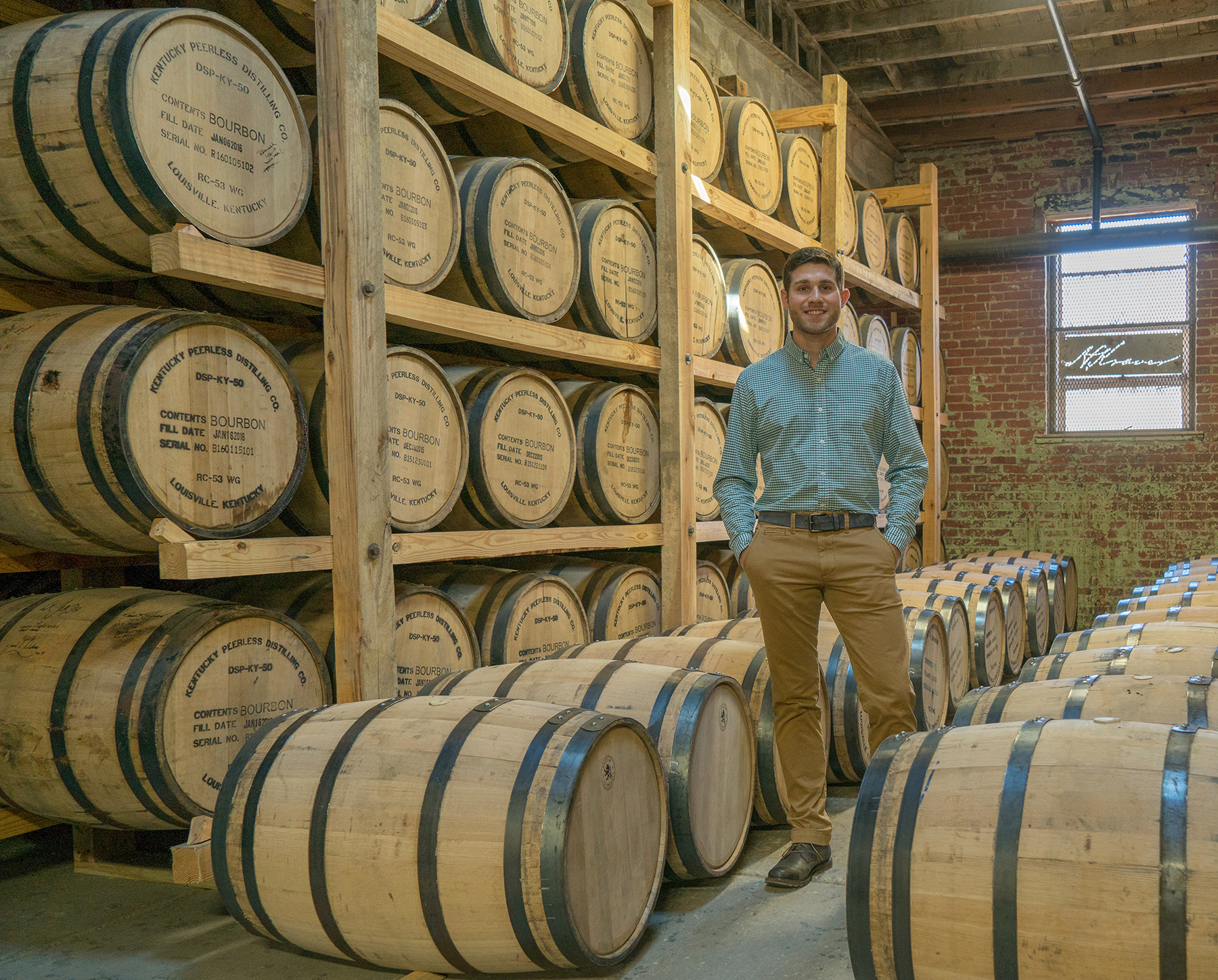
Do you notice if rye or bourbon takes better to certain placements in the warehouse? Or do you feel like it’s just a crapshoot of every barrel is going to be unique?
Yes and no. When you look at our rickhouses, both are only single-story rickhouses, so it’s not something where there are massive different climates at the bottom of the facility versus the top the way you would see in a seven- or six-story warehouse. We have maybe 16 feet separating top and bottom where those bigger warehouses may be operating with a hundred-foot difference. Because of that, there’s going to be cool, fresh air at the bottom and very hot arid air at the top. We don’t see that sort of difference.
Now that being said, even though it is a very similar climate, each barrel is going to be unique. It doesn’t matter if it’s the same mash bill, if it’s the same day of filling, if they were filled side-by-side, or if they were stored side-by-side, at the end of the day, each barrel is going to be unique and different, which is actually awesome.
It makes it really rewarding and it really takes away this notion that you can just taste one barrel and apply those tasting notes to the whole lot. Or you can say, “Okay, well we had this acceptance rate, we can just take these barrels, these barrels, these barrels and make a batch from it.” That’s not something we prescribe to. If you’re at a facility processing thousands and thousands of barrels you may be able to do that.
You have to dig in.
We actually go in and we taste every single barrel.
And who’s helping you do that?
It’ll be myself, Nick Klee, who is our morning distiller, and John Wadell, who is our kind of do-it-all gentleman who also does our single barrel program. The three of us are the palates that taste every one of these barrels and determine first off, is it ready to be a Peerless barrel? And then beyond that, is it a small batch? Is it single? Where does it fit within our portfolio? And that’s where it gets really fun.
Have you ever pulled a rye barrel that tastes like bourbon or a bourbon barrel that tastes like rye?
Absolutely. It’s not so much that it’s indistinguishable, it’s just that it does a really good impression.
What’s your process for deciding whether these unicorn barrels become single barrel releases or layered into a small batch?
We figure it out as we go. For us, the barrels of rye that are very similar to our small batch but maybe they don’t go out on any limbs — there’s nothing bad about them, they just don’t separate themselves from the pack — those are ones that we mingle. But if you did have a barrel that just was crazy different than the standard profile and it is also really technically sound — it has a beginning, middle, end, the nose, the palate, the mouthfeel, it has a very dense flavor profile — those are ones that we promote as single barrels.
Everybody finds a home, so to speak.
The only ones that haven’t, that don’t really have a home, are ones that are not mature yet. Ones that maybe haven’t turned that corner or maybe they still have a note that’s yet to develop or maybe a note that we’re hoping goes away, those are ones that’ll stay within our rickhouse for another year, and then we’ll try them again. And it’s not that the barrel’s bad, it’s just that it hasn’t had time to mature. It’s a late bloomer.
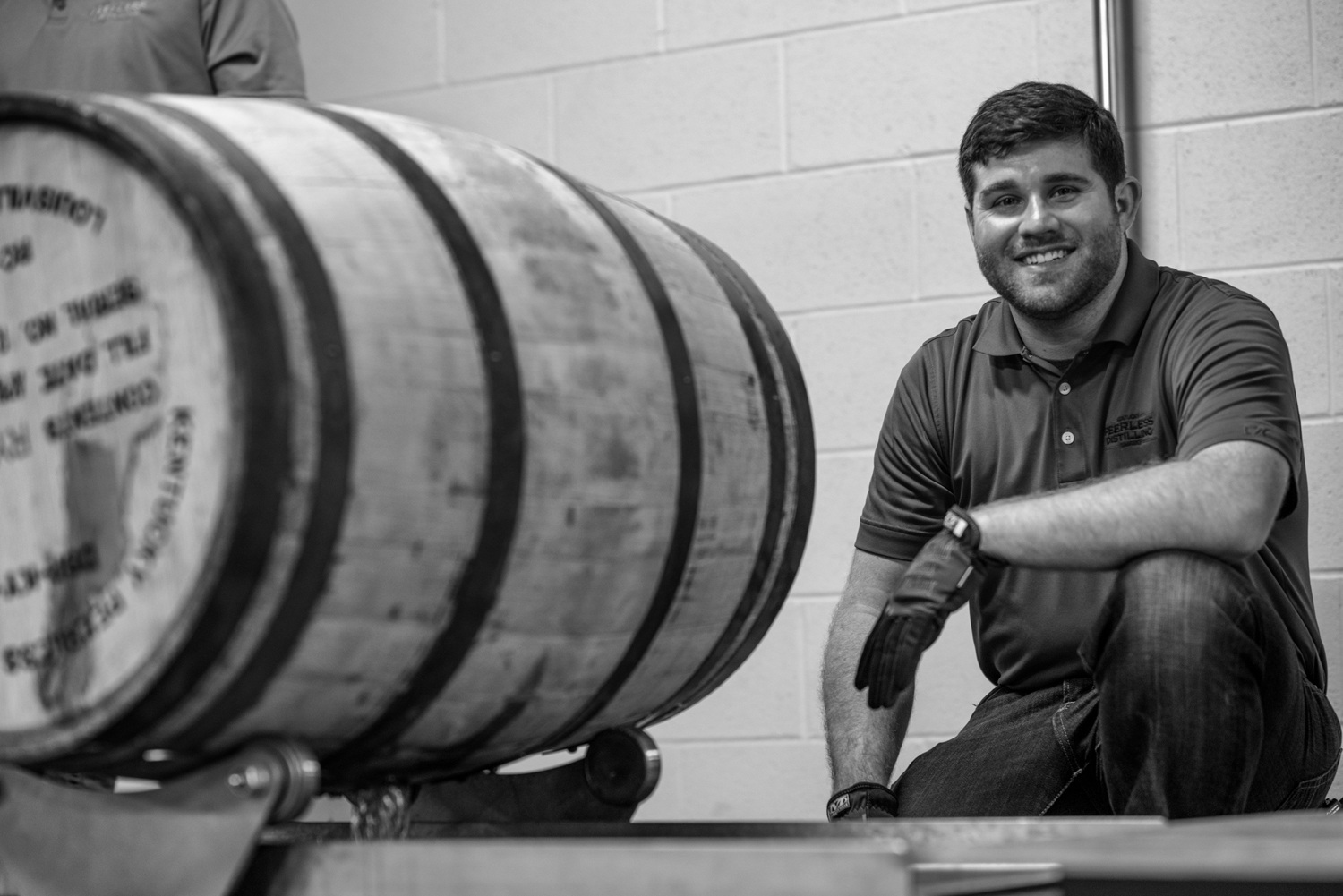
What do you think people mistake the most about rye whiskey and what would you correct that might have falsely imprinted in people’s minds about rye?
Well, there’s a lot of rye out there that follows a very narrow flavor profile. For most people, when they think of rye whiskey, not knowing how it’s made, not knowing the mash bills or the proofs or the ages or anything, they likely follow the standard sour mash 95 percent rye. That’s the one that’s barreled at a high-strength and proofed down where the main characters that come through are very spicy, very peppery, and has that sour mash note. People understand rye whiskey as a very narrow flavor profile and, as a result, if they like it, they love “all” rye whiskey in their mind. If they don’t like it, which is more predominant, they just write off the whole category saying, “Ah, that’s not for me.” It makes for very loyal rye fans and it scares a lot of people off.
The biggest thing I would say as advocacy for rye is be willing to understand that there are new horizons or different flavor profiles and different people making different whiskeys that are still very much rye. It’s still anchored as being “rye,” but maybe show off some different complexities. For instance, we have a little bit of corn in our rye mash. It produces a sweeter, more floral rye whiskey. We use our sweet mash, we use our low barrel entry proof, and, at the end of the day, we have been coined a bourbon drinker’s rye.
And it’s not so much that it tastes like a bourbon, but you get the complexity, the flavor, diversity, the depth of character that you’re used to seeing within a bourbon, but it’s rye. And so my biggest thing to tell people would be, ‘be willing to expand the horizons and revisit the category. They all don’t taste alike.’
The last question. When you say a “sour mash note,” can you explain that as a flavor profile?
The best way I could describe it: When you have a slice of sourdough bread or French bread, for instance, you know how it has that little bit of tartness within the bread, that little bit of bite if you will?
Sure.
When you have a sour mash, it’s like you’ve taken that note and you’ve applied it to a whole batch of beer. But when you go to distill it, it becomes ultra-concentrated and it can be off-putting if you distill it at too low of a proof. If you do certain things like you don’t give it enough time in the barrel, it can be off-putting. There’s a lot of really good sour mash whiskey out there and that sour mash note can be very favorable in many different scenarios. But for us, we felt that it caused us some collateral damage. If you were to do a sour mash, you have to clean up that sour, gritty note.
If you distill at a high proof to avoid concentrating that note, then what happens is a lot of the fruits, florals, grasses, herbs, the grain, things that would have been very good at that lower proof, now have been stripped out along with that sour note. So you end up removing some of the character from the whiskey that we really wanted to hold onto.
